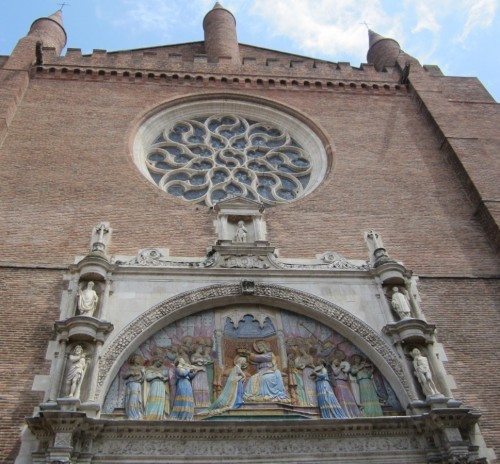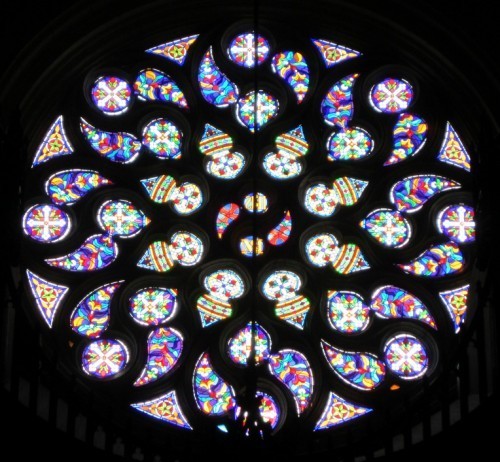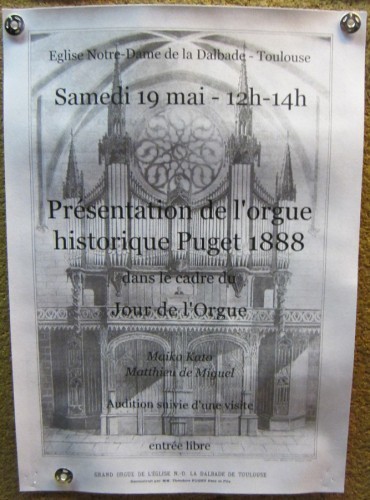The organ of Eglise Notre-Dame La Dalbade – Part I
PART ONE
This post is all Robin’s fault. After all, if she hadn’t mentioned folding origami the other day, I would not have desired to fold some origami myself, then gotten lost looking for a little paper shop, seen an intriguing old-looking building in the process of finding the correct street, gone around to the front of the intriguing old-looking building, gone inside, and discovered that there was going to be something that involved organs the next day.
And if Robin hadn’t, in the past, posted occasionally about Oisin and his obsession about organs, and a little bit about how organs are really cool, I might not have gone to said event involving organs. But being sort of a musician, and thinking that organs might be kind of interesting, my boyfriend and I went.
I was expecting a recital or something. What we got was a brief recital… followed quickly by the opportunity to go up into the organ loft, see the keyboards, the stops, the pedals, hear the organ from the galleries as well as from the organ loft, go into the back and see (some of) the insides of the organ, see and hear the various pipes, hear how the different stops affect the sound of the instrument, watch a little of how the mechanics of this incredible instrument work, and then get to doodle around a little on the instrument myself.
—

Front of the church
The Eglise Notre-Dame La Dalbade is in the Carmes neighborhood of Toulouse. Surrounded by other old buildings*, it stands on one of the many twisty streets that meander through this medieval city. When I made a wrong turn looking for the paper store and saw the high walls with the old gothic buttresses, I had to investigate. Built of the red brick that gives the city its nickname of La Ville Rose, it has an entrance with carved columns and a beautiful mural depicting the coronation of the Virgin Mary surrounded by angelic musicians.
It seems that the original church, built in the 6th century, was white – hence its name**. After being destroyed in a fire in the 15th century and rebuilt in the 16th, it acquired its current red brick and the tallest bell tower in Toulouse. It houses an organ, built by Eugène Puget in 1888***. In 1926, the bell tower collapsed, taking a small secondary organ and a large portion of the church with it****. Luckily, the main organ was minimally damaged, and the church was rebuilt in the 50s (some of the organ’s restoration at that time was performed by Eugène’s grandson Maurice).
When I ventured inside Friday afternoon, I admired the vaulted ceilings, the stained-glass windows, the paintings and statues in the alcoves… all the usual things I look at when I enter these old churches. Some churches, including this one, have fabulous organs – the detailed carving of the dark wood is always amazing to behold. This organ was designed to frame a beautiful rose window.

Rose window
I was a little surprised to hear someone playing on it, though – all the other organs I’ve seen have been silent when I visited. They were clearly practicing – the same run was played several times, the music stopped and started, and after a while, I became aware that there were two people in the organ loft – the player and someone who seemed to be instructing the player. I enjoyed the music, such as it was, and after taking several photographs of the church’s interior, I prepared to leave.
As I turned to the exit, I took a quick look at the bulletin board. A poster caught my eye – Presentation de l’orgue historique Puget 1888, it said. The date was, serendipitously, that of the next day. I took a picture of it (so I’d remember) and showed it to my boyfriend that evening after he got home. He thought it might be interesting – why not go?

Flyer. Background is a drawing (I believe by Puget) of the original organ’s conception and/or construction (I am not completely clear on that part).
And so, as the morning turned to noon on Saturday, we entered the church. . . .
* * *
* The building across the way, for example, has a plaque on it dating it to the 16th century.
** That would be the Dalbade part (dealbata = whitewashed in Latin)
*** According to this website ( http://www.toulouse-les-orgues.org/le... ), Puget actually rebuilt and expanded on a previously present organ built in 1850 by Prosper Moitessier.
**** The French Wikipedia site has a couple photos of the tower before and after its collapse. http://fr.wikipedia.org/wiki/%C3%89glise_Notre-Dame_de_la_Dalbade
Robin McKinley's Blog
- Robin McKinley's profile
- 7243 followers



